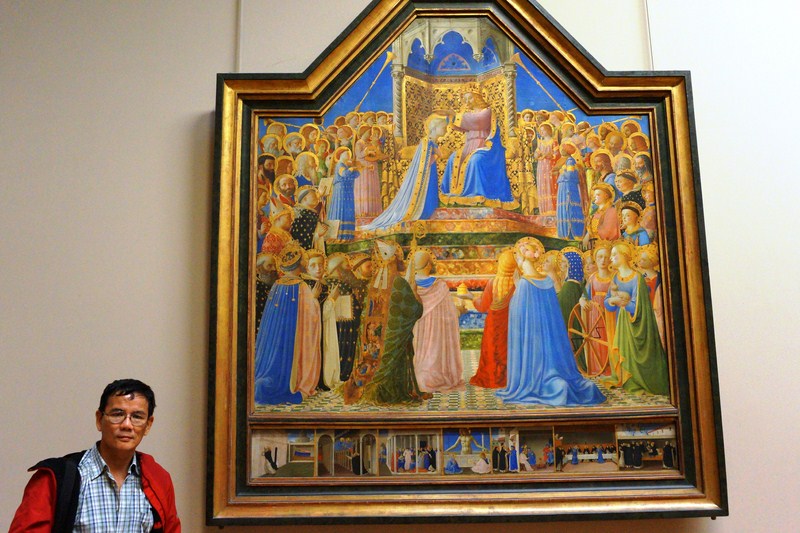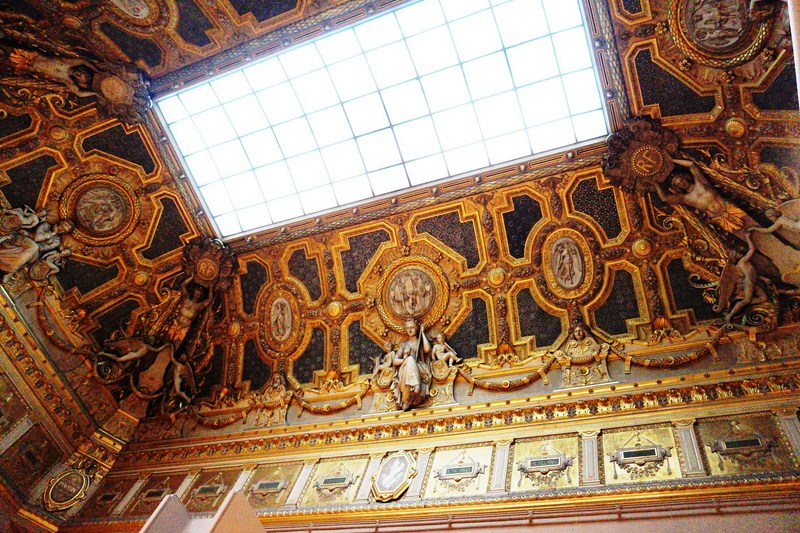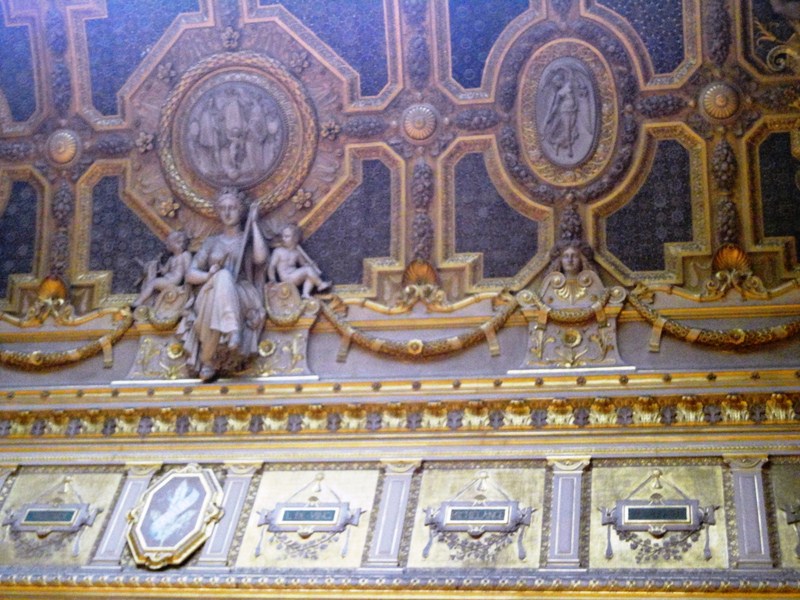The Salon Carré (Square Salon), one of the most emblematic rooms in the Louvre Museum, was built by French Baroque architect Louis Le Vau at the east end of the Grand Gallery (Grande Galerie) after the fire of 1661. It links the Apollo Gallery with the Grand Gallery.
Check out “Louvre Museum“ “Louvre Museum – Apollo Gallery,” “Louvre Museum – Painting Collection” and “Louvre Museum – Grand Gallery”
Between 1667 and 1789, the French monarchy sponsored periodic exhibitions of works by members of the Académie Royale de Peinture et de Sculpture (Royal Academy of Painting and Sculpture) and, from 1725, the Salon Carré and nearby rooms in the Louvre were the setting for these exhibitions. The official French art exhibition in Paris took its name from the Salon Carré. In 1793, the Louvre’s first public museum opened here and, for many years, it housed exhibitions of contemporary art.

The author beside The Coronation of the Virgin, a 213 cm × 211 cm (84 in × 83 in) painting by the Italian early Renaissance master Fra Angelico, was executed around 1434-1435. The composition is based on the pyramidal structure of the steps and the figures of the Virgin and Christ.
On April 2, 1810, Napoleon I and Marie-Louise of Austria were married before God in a ‘chapel’ created by architects Charles Percier and Pierre-Francois-Leonard Fontaine out of the Salon Carré. In order to reach this large space usually given over the exhibition of paintings, the wedding procession and cortege had to walk all the way from the Tuileries Palace and down a great part of the Grande Galerie.
An excerpt from Fontaine’s Journal stated that Vivant Denon, the director of the Louvre, had been opposed to removal of the very large paintings in that gallery in order to make way for the two-level tribunes which were to be built to accommodate the congregation. However, the emperor, on hearing of this intransigence, “with animosity, gave the order for the paintings to be removed, and as for any which could not be removed, they should be burned”!
The threat was effective and the Salon Carré was emptied of its masterpieces and the tribunes built. Furthermore, an altar was erected facing the entrance to the gallery, topped with a large cross and six chased vermeil candlesticks made by Odiot. The walls were draped with gold embroidered hangings.
From 1848 up until World War I, the Salon Carré was used to display the Louvre’s masterpieces. The gallery now displays Italian paintings from the 12th to 15th centuries and from various schools. This magnificent, Baroque skylit gallery has towering windows and a vaulted gilt ceiling engraved with the names of painters, by nation, from the Renaissance (Peter Paul Rubens, Raphael, etc.) and Bartolome Esteban Murillo to Nicolas Poussin.

Jandy beside the The Battle of San Romano of Florentine painter Paolo Uccello, a set of three paintings in egg tempera on wooden panels, each over 3 m. long, depicts events that took place at the Battle of San Romano between Florentine and Sienese forces in 1432. They are significant as revealing the development of linear perspective in early Italian Renaissance painting, and are unusual as a major secular commission.
Salon Carre: Room 708, First Floor, Denon Wing, Louvre, Paris 75001, France. Tel: +33 1 40 20 50 50. Open daily, except Tuesdays and holidays, 9 AM- 6 PM (until 10 PM on Wednesday and Friday evenings).
The Louvre has three entrances: the main entrance at the pyramid, an entrance from the Carrousel du Louvre underground shopping mall, and an entrance at the Porte des Lions (near the western end of the Denon wing).
Admission is free, from October to March, on the first Sunday of every month. Still and video photography is permitted for private, noncommercial use only in the galleries housing the permanent collection. The use of flash or other means of artificial lighting is prohibited. Photography and filming are not permitted in the temporary exhibition galleries.
How To Get There: the Louvre can be reached via Metro lines 1 and 7, station Palais Royal – Musée du Louvre Métro or the Louvre-Rivoli stations. By bus, take No. 21, 24, 27, 39, 48, 68, 69, 72, 81, 95 as well as the touristic Paris l’Open Tour. By car, there is an underground parking reachable by Avenue du Général Lemonier, every day from 7 AM – 11 PM.


